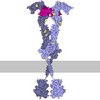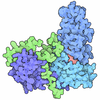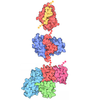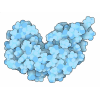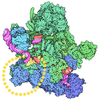+ Open data
Open data
- Basic information
Basic information
| Entry | Database: PDB / ID: 8vsc | ||||||
|---|---|---|---|---|---|---|---|
| Title | L-TGF-b1/GARP | ||||||
 Components Components |
| ||||||
 Keywords Keywords | SIGNALING PROTEIN / TGFb / Complex | ||||||
| Function / homology |  Function and homology information Function and homology informationestablishment of protein localization to extracellular region / cellular response to acetaldehyde / adaptive immune response based on somatic recombination of immune receptors built from immunoglobulin superfamily domains / positive regulation of microglia differentiation / regulation of interleukin-23 production / branch elongation involved in mammary gland duct branching / positive regulation of primary miRNA processing / Influenza Virus Induced Apoptosis / regulation of branching involved in mammary gland duct morphogenesis / negative regulation of skeletal muscle tissue development ...establishment of protein localization to extracellular region / cellular response to acetaldehyde / adaptive immune response based on somatic recombination of immune receptors built from immunoglobulin superfamily domains / positive regulation of microglia differentiation / regulation of interleukin-23 production / branch elongation involved in mammary gland duct branching / positive regulation of primary miRNA processing / Influenza Virus Induced Apoptosis / regulation of branching involved in mammary gland duct morphogenesis / negative regulation of skeletal muscle tissue development / macrophage derived foam cell differentiation / frontal suture morphogenesis / regulation of enamel mineralization / regulation of cartilage development / TGFBR2 MSI Frameshift Mutants in Cancer / regulation of striated muscle tissue development / regulatory T cell differentiation / tolerance induction to self antigen / regulation of blood vessel remodeling / regulation of protein import into nucleus / embryonic liver development / extracellular matrix assembly / columnar/cuboidal epithelial cell maturation / negative regulation of natural killer cell mediated cytotoxicity directed against tumor cell target / negative regulation of hyaluronan biosynthetic process / type III transforming growth factor beta receptor binding / positive regulation of cardiac muscle cell differentiation / myofibroblast differentiation / odontoblast differentiation / connective tissue replacement involved in inflammatory response wound healing / positive regulation of odontogenesis / Langerhans cell differentiation / negative regulation of macrophage cytokine production / positive regulation of exit from mitosis / positive regulation of smooth muscle cell differentiation / TGFBR2 Kinase Domain Mutants in Cancer / positive regulation of isotype switching to IgA isotypes / secondary palate development / positive regulation of mesenchymal stem cell proliferation / SMAD2/3 Phosphorylation Motif Mutants in Cancer / TGFBR1 KD Mutants in Cancer / mammary gland branching involved in thelarche / positive regulation of receptor signaling pathway via STAT / membrane protein intracellular domain proteolysis / retina vasculature development in camera-type eye / heart valve morphogenesis / TGFBR3 regulates TGF-beta signaling / bronchiole development / response to laminar fluid shear stress / hyaluronan catabolic process / positive regulation of vasculature development / lens fiber cell differentiation / positive regulation of extracellular matrix assembly / ATP biosynthetic process / receptor catabolic process / negative regulation of extracellular matrix disassembly / positive regulation of branching involved in ureteric bud morphogenesis / type II transforming growth factor beta receptor binding / TGFBR1 LBD Mutants in Cancer / negative regulation of biomineral tissue development / response to salt / oligodendrocyte development / type I transforming growth factor beta receptor binding / receptor ligand inhibitor activity / germ cell migration / positive regulation of mononuclear cell migration / positive regulation of chemotaxis / endoderm development / phospholipid homeostasis / negative regulation of myoblast differentiation / negative regulation of cell-cell adhesion mediated by cadherin / cell-cell junction organization / response to vitamin D / response to cholesterol / positive regulation of vascular permeability / negative regulation of interleukin-17 production / surfactant homeostasis / deubiquitinase activator activity / transforming growth factor beta binding / negative regulation of release of sequestered calcium ion into cytosol / positive regulation of chemokine (C-X-C motif) ligand 2 production / digestive tract development / phosphate-containing compound metabolic process / aortic valve morphogenesis / positive regulation of fibroblast migration / negative regulation of ossification / RUNX3 regulates CDKN1A transcription / sprouting angiogenesis / face morphogenesis / neural tube development / positive regulation of regulatory T cell differentiation / negative regulation of phagocytosis / negative regulation of cytokine production / ureteric bud development / Molecules associated with elastic fibres / positive regulation of epidermal growth factor receptor signaling pathway / negative regulation of neuroblast proliferation / muscle cell cellular homeostasis / ventricular cardiac muscle tissue morphogenesis / Syndecan interactions Similarity search - Function | ||||||
| Biological species |  Homo sapiens (human) Homo sapiens (human) | ||||||
| Method | ELECTRON MICROSCOPY / single particle reconstruction / cryo EM / Resolution: 3 Å | ||||||
 Authors Authors | Jin, M. / Cheng, Y. / Nishimura, S.L. | ||||||
| Funding support |  United States, 1items United States, 1items
| ||||||
 Citation Citation |  Journal: Cell / Year: 2024 Journal: Cell / Year: 2024Title: Dynamic allostery drives autocrine and paracrine TGF-β signaling. Authors: Mingliang Jin / Robert I Seed / Guoqing Cai / Tiffany Shing / Li Wang / Saburo Ito / Anthony Cormier / Stephanie A Wankowicz / Jillian M Jespersen / Jody L Baron / Nicholas D Carey / Melody ...Authors: Mingliang Jin / Robert I Seed / Guoqing Cai / Tiffany Shing / Li Wang / Saburo Ito / Anthony Cormier / Stephanie A Wankowicz / Jillian M Jespersen / Jody L Baron / Nicholas D Carey / Melody G Campbell / Zanlin Yu / Phu K Tang / Pilar Cossio / Weihua Wen / Jianlong Lou / James Marks / Stephen L Nishimura / Yifan Cheng /  Abstract: TGF-β, essential for development and immunity, is expressed as a latent complex (L-TGF-β) non-covalently associated with its prodomain and presented on immune cell surfaces by covalent association ...TGF-β, essential for development and immunity, is expressed as a latent complex (L-TGF-β) non-covalently associated with its prodomain and presented on immune cell surfaces by covalent association with GARP. Binding to integrin αvβ8 activates L-TGF-β1/GARP. The dogma is that mature TGF-β must physically dissociate from L-TGF-β1 for signaling to occur. Our previous studies discovered that αvβ8-mediated TGF-β autocrine signaling can occur without TGF-β1 release from its latent form. Here, we show that mice engineered to express TGF-β1 that cannot release from L-TGF-β1 survive without early lethal tissue inflammation, unlike those with TGF-β1 deficiency. Combining cryogenic electron microscopy with cell-based assays, we reveal a dynamic allosteric mechanism of autocrine TGF-β1 signaling without release where αvβ8 binding redistributes the intrinsic flexibility of L-TGF-β1 to expose TGF-β1 to its receptors. Dynamic allostery explains the TGF-β3 latency/activation mechanism and why TGF-β3 functions distinctly from TGF-β1, suggesting that it broadly applies to other flexible cell surface receptor/ligand systems. | ||||||
| History |
|
- Structure visualization
Structure visualization
| Structure viewer | Molecule:  Molmil Molmil Jmol/JSmol Jmol/JSmol |
|---|
- Downloads & links
Downloads & links
- Download
Download
| PDBx/mmCIF format |  8vsc.cif.gz 8vsc.cif.gz | 423.4 KB | Display |  PDBx/mmCIF format PDBx/mmCIF format |
|---|---|---|---|---|
| PDB format |  pdb8vsc.ent.gz pdb8vsc.ent.gz | 348.2 KB | Display |  PDB format PDB format |
| PDBx/mmJSON format |  8vsc.json.gz 8vsc.json.gz | Tree view |  PDBx/mmJSON format PDBx/mmJSON format | |
| Others |  Other downloads Other downloads |
-Validation report
| Summary document |  8vsc_validation.pdf.gz 8vsc_validation.pdf.gz | 1.1 MB | Display |  wwPDB validaton report wwPDB validaton report |
|---|---|---|---|---|
| Full document |  8vsc_full_validation.pdf.gz 8vsc_full_validation.pdf.gz | 1.1 MB | Display | |
| Data in XML |  8vsc_validation.xml.gz 8vsc_validation.xml.gz | 42.4 KB | Display | |
| Data in CIF |  8vsc_validation.cif.gz 8vsc_validation.cif.gz | 61.6 KB | Display | |
| Arichive directory |  https://data.pdbj.org/pub/pdb/validation_reports/vs/8vsc https://data.pdbj.org/pub/pdb/validation_reports/vs/8vsc ftp://data.pdbj.org/pub/pdb/validation_reports/vs/8vsc ftp://data.pdbj.org/pub/pdb/validation_reports/vs/8vsc | HTTPS FTP |
-Related structure data
| Related structure data |  43493MC 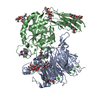 8vs6C 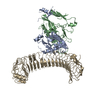 8vsbC  8vsdC C: citing same article ( M: map data used to model this data |
|---|---|
| Similar structure data | Similarity search - Function & homology  F&H Search F&H Search |
- Links
Links
- Assembly
Assembly
| Deposited unit | 
|
|---|---|
| 1 |
|
- Components
Components
| #1: Protein | Mass: 44399.094 Da / Num. of mol.: 2 Source method: isolated from a genetically manipulated source Source: (gene. exp.)  Homo sapiens (human) / Gene: TGFB1, TGFB / Production host: Homo sapiens (human) / Gene: TGFB1, TGFB / Production host:  Homo sapiens (human) / References: UniProt: P01137 Homo sapiens (human) / References: UniProt: P01137#2: Protein | | Mass: 66056.297 Da / Num. of mol.: 1 Source method: isolated from a genetically manipulated source Source: (gene. exp.)  Homo sapiens (human) / Gene: LRRC32, D11S833E / Production host: Homo sapiens (human) / Gene: LRRC32, D11S833E / Production host:  Homo sapiens (human) / References: UniProt: Q14392 Homo sapiens (human) / References: UniProt: Q14392Has protein modification | Y | |
|---|
-Experimental details
-Experiment
| Experiment | Method: ELECTRON MICROSCOPY |
|---|---|
| EM experiment | Aggregation state: PARTICLE / 3D reconstruction method: single particle reconstruction |
- Sample preparation
Sample preparation
| Component | Name: L-TGF-b1/GARP complex / Type: COMPLEX / Entity ID: all / Source: RECOMBINANT |
|---|---|
| Molecular weight | Value: 0.18 MDa / Experimental value: NO |
| Source (natural) | Organism:  Homo sapiens (human) Homo sapiens (human) |
| Source (recombinant) | Organism:  Homo sapiens (human) Homo sapiens (human) |
| Buffer solution | pH: 7.4 |
| Specimen | Embedding applied: NO / Shadowing applied: NO / Staining applied: NO / Vitrification applied: YES |
| Vitrification | Cryogen name: ETHANE |
- Electron microscopy imaging
Electron microscopy imaging
| Experimental equipment |  Model: Titan Krios / Image courtesy: FEI Company |
|---|---|
| Microscopy | Model: FEI TITAN KRIOS |
| Electron gun | Electron source:  FIELD EMISSION GUN / Accelerating voltage: 300 kV / Illumination mode: FLOOD BEAM FIELD EMISSION GUN / Accelerating voltage: 300 kV / Illumination mode: FLOOD BEAM |
| Electron lens | Mode: BRIGHT FIELD / Nominal defocus max: 2200 nm / Nominal defocus min: 1100 nm |
| Image recording | Electron dose: 46 e/Å2 / Film or detector model: GATAN K3 (6k x 4k) |
- Processing
Processing
| CTF correction | Type: PHASE FLIPPING AND AMPLITUDE CORRECTION | ||||||||||||||||||||||||
|---|---|---|---|---|---|---|---|---|---|---|---|---|---|---|---|---|---|---|---|---|---|---|---|---|---|
| 3D reconstruction | Resolution: 3 Å / Resolution method: FSC 0.143 CUT-OFF / Num. of particles: 318954 / Symmetry type: POINT | ||||||||||||||||||||||||
| Refine LS restraints |
|
 Movie
Movie Controller
Controller









 PDBj
PDBj


